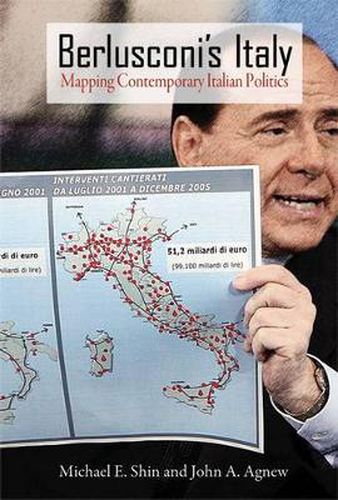Readings Newsletter
Become a Readings Member to make your shopping experience even easier.
Sign in or sign up for free!
You’re not far away from qualifying for FREE standard shipping within Australia
You’ve qualified for FREE standard shipping within Australia
The cart is loading…






Since 1994, Italian politics has been dominated by the larger-than-life figure of Silvio Berlusconi. Blending discussion of personalities, parties, and policies with detailed geographical analyses, this book provides innovative insight into Berlusconi’s career. Berlusconi’s Italy provides a fresh, thoroughly informed account of how Italy’s richest man came to be its political leader. Without dismissing the importance of personalities and political parties, it emphasizes the significance of changes in voting behaviors that led to the rise–and eventual fall–of Silvio Berlusconi, the millionaire media baron who became prime minister. Armed with new data and new analytic tools, Michael Shin and John Agnew reveal that regional politics and shifting geographical voting patterns were far more important to Berlusconi’s successes than the widely credited role of the mass media. Shin and Agnew reject the prevailing orthodoxy about how coalitions are organized and replaced in Italy. Instead, using recently developed methods of spatial analysis, they offer a compelling new argument about contextual re-creation and mutation.They conclude that Berlusconi’s success (and later defeat) can be best understood in geographic terms, and they suggest that geographical analysis has a useful role to play in examining political behavior in Italy and beyond.
$9.00 standard shipping within Australia
FREE standard shipping within Australia for orders over $100.00
Express & International shipping calculated at checkout
Since 1994, Italian politics has been dominated by the larger-than-life figure of Silvio Berlusconi. Blending discussion of personalities, parties, and policies with detailed geographical analyses, this book provides innovative insight into Berlusconi’s career. Berlusconi’s Italy provides a fresh, thoroughly informed account of how Italy’s richest man came to be its political leader. Without dismissing the importance of personalities and political parties, it emphasizes the significance of changes in voting behaviors that led to the rise–and eventual fall–of Silvio Berlusconi, the millionaire media baron who became prime minister. Armed with new data and new analytic tools, Michael Shin and John Agnew reveal that regional politics and shifting geographical voting patterns were far more important to Berlusconi’s successes than the widely credited role of the mass media. Shin and Agnew reject the prevailing orthodoxy about how coalitions are organized and replaced in Italy. Instead, using recently developed methods of spatial analysis, they offer a compelling new argument about contextual re-creation and mutation.They conclude that Berlusconi’s success (and later defeat) can be best understood in geographic terms, and they suggest that geographical analysis has a useful role to play in examining political behavior in Italy and beyond.